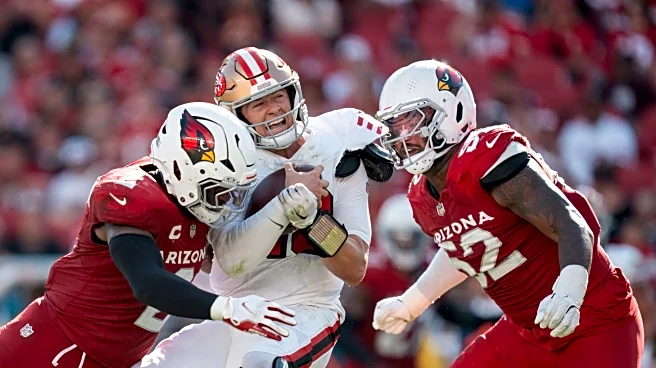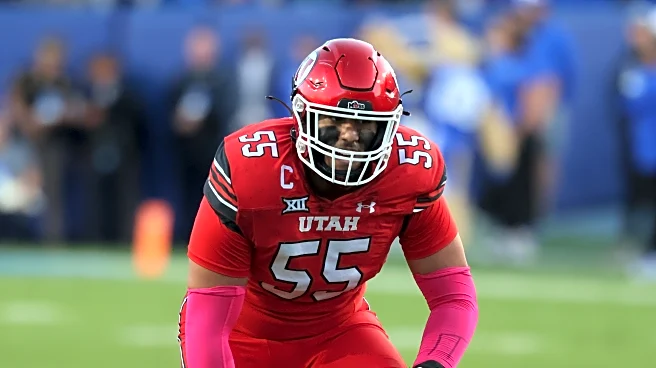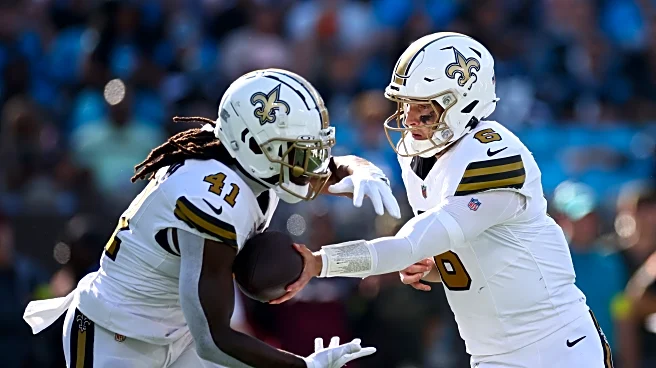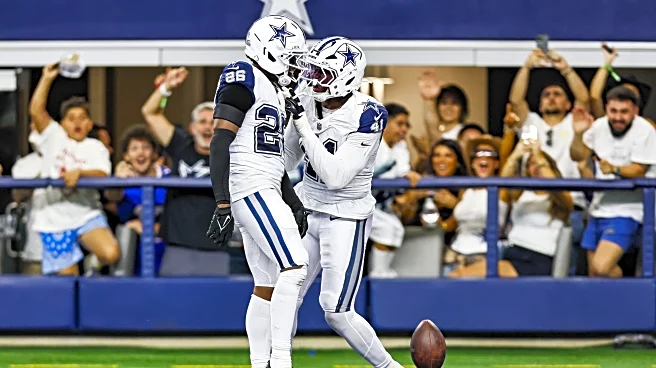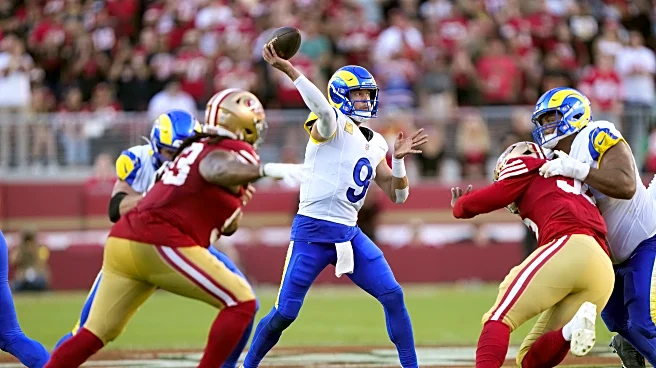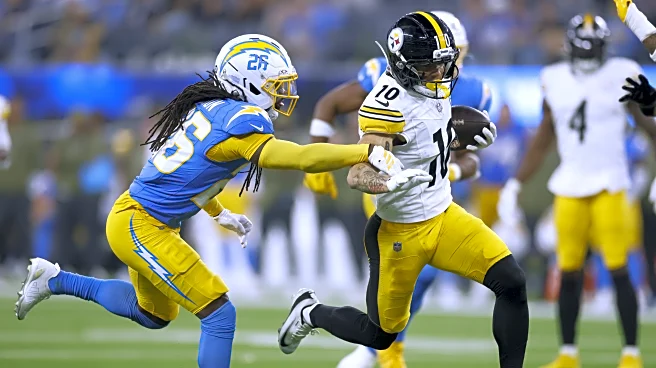The San Francisco 49ers started it all. It’s their fault.
In Weeks 1 and 2, the Arizona Cardinals defeated the New Orleans Saints and the Carolina Panthers to begin this season 2-0-0. Their next contest
was on the road against the 49ers.
RELATED: CARDINALS OPEN AS HOME UNDERDOGS
In the fourth quarter, the score was 13-13. With 3:35 left in the game, Blake Gillikin punted, which was down at the San Francisco six-yard line. On first down, right off the snap, DT Calais Campbell split the gap between RG Dominick Puni and C Jake Brendel. Campbell had a straight shot at QB Mac Jones and placed a hand on him, but the QB was able to dodge the grab as LB Jordan Burch now approached Jones.
A yellow flag could be seen being tossed from the back of the end zone. Jones then darted to the middle of the end zone, cut up the field, and was tackled by S Budda Baker back at the six. The penalty? Puni had no chance at Campbell and, in an effort to slow him down, held him. This action occurred in the end zone. By rule, it is a safety.
Two points were added to the Cardinals’ score, plus they got the ball with 3:15 remaining in the game.

Arizona’s drive began at its own 35-yard line. The clock showed 3:10. After four plays and one first down conversion, the Cardinals had a third-and-nine at the 50. QB Kyler Murray found WR Zay Jones open, threw a great pass, to which Jones lost control as he fell to the turf two yards past the first down marker. Clock: 1:54. Instead of a first down catch, Arizona had to punt.
The Niners took control at their own 20. They then completed passes of 11 yards, 10, 7, 11, and 20, and were helped by a five-yard illegal use of hands penalty by S Denzel Burke. The 20-yard pass completion by RB Christian McCaffrey placed the ball at Arizona’s 16-yard line. With four seconds left, San Fran’s K Eddie Pineiro nailed a 35-yard field goal for the 16-15 win.
The drive took 10 plays and encompassed 63 yards and used just 1:46 of clock.
This began the jinx that Arizona conjured up with having a lead going late into the fourth quarter, yet losing. One opponent after another used this same strategy.
And now comes the rebound game against division foe San Francisco. This time, the contest is at home in the afternoon slot televised by FOX. San Francisco is now 6-4-0 and 3-1-0 in the division. They say a team is only as good as who they beat. The 49ers defeated the Seattle Seahawks 17-13, the Saints 26-21, Arizona 16-15, the Los Angeles Rams 26-23, the Atlanta Falcons 20-10, and the New York Football Giants 34-24.
Beating both the Seahawks and the Rams is a big deal. Both squads are exceptional teams with identical 7-2-0 records. The Cardinals were spanked by Seattle and have two games ahead on the schedule with the Rams.
The fact that Arizona should have beaten the 49ers in their first meeting has nothing to do with this game. It never does. Players get hurt and are replaced. Coaches see things differently and formulate plans to attack in other ways.
ESPN predicts that the 49ers have a 63.7% chance of winning on Sunday. What are the keys for the Cardinals to defeat San Fran?
Dominate the offensive intermediate zone
The 49ers do not have a competent pass defense. They possess good safety coverage, but their cornerbacks are the defense’s weak link. The Cardinals need to throw the 8–12-yard passes and then insert some 20-yard plays.

Obviously, this begins with TE Trey McBride. Throw to him often and move the chains. And why isn’t this offense using Michael Wilson more? He comes through when he is thrown the ball. The Niners’ linebacker group is good at tackling, but lacks good coverage skills against tight ends.
The short passing game is not the best option, and throwing the long ball will be different now that WR Marv Harrison is down and unavailable. Wilson and WR Greg Dortch have the speed, but the San Fran safety group is an exceptional group.
The 49ers are ranked #26 in defense of the pass. Exploit it.
Contain the 49ers’ big-play threats
Last game, McCaffrey was used to get good gains not by running the ball, but by the short passes and screen plays. Take that away.

Use and designate one player to play the spy on McCaffrey. S Budda Baker or LB Zaven Collins would probably work. LB Akeem Davis-Gaither would not be the best choice, as he does not have the speed to stay with McCaffrey if he took off on a long route, and is a very good route runner.
WR Ricky Pearsall is their deep threat. Having a safety go over the top would hinder his ability to catch passes. Allow the other receivers to do the dirty work.
The Cardinals will need to stop the 49ers’ explosive plays.
Stop the interior running game
Other than Campbell, the interior of the defense has not played well against the run.
This will come into play against the Niners. Their inside running game has improved by eight points since Week 6. They average 4.8 yards per carry in the last four games between the tackles, up from 3.1 yards per rushing attempt. That is scary.
Arizona is giving up an average of 4.3 yards per carry, but 5.1 yards per attempt inside the tackle box.

Campbell is the only reason those numbers aren’t higher. The fact that rookie DT Walter Nolen is now available should help the run-stopping game tremendously because DTs Dalvin Tomlinson and P.J. Mustipher aren’t getting it done. This duo has 32 total tackles combined this year and has played all nine games.
Teams have found how to attack this Cardinals defense is to get up the gut and move the defensive tackles out of harm’s way, then pull a guard to go into the hole and take out the first linebacker. Wait a sec, the statement, “….and move the defensive tackles out of harm’s way…” does not apply to Campbell.
Since they first met, the 49ers have diversified their rushing attack a bit more by using power running from Brian Robinson along with McCaffrey’s finesse.
Start Nolen and pair him with Campbell, and maintain their gaps. Make both runners have to bounce outside, where a linebacker or safety can make the play.
